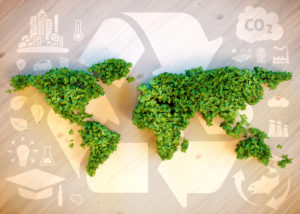Business owners and property managers know that recycling helps to reduce labor and waste hauling costs, while improving workplace safety, space, & cleanliness. Did you know that recycling also saves energy? In an age when energy efficiency and conservation are paramount, recycling can be a catalyst for reducing costs and lowering the burden place on our valuable natural resources.
How does Recycling Save Energy?
Recycling saves energy by reducing or eliminating the need to make materials from scratch. Making products from scratch can be both labor intensive and expensive to collect, move and refine the natural resources needed for paper, aluminum, plastic, and so on. By using recycled materials instead of pulling new natural resources, manufacturers can make the same products with less energy and expense. Since recycled materials have already been refined and processed once; the second time around, manufacturing is much less energy-intensive than the first. When companies don’t have to process the raw materials from scratch, new products from recycled materials use up to 30% less energy. Let’s talk more about how the environment benefits when we recycle aluminum, plastic, and paper.
1. How Recycling Aluminum Saves Energy
More than 100 billion aluminum cans are sold in the United States each year, with less than half being recycled. With the amount of energy it takes to make one virgin aluminum can, 20 recycled cans can be manufactured. The process is fast and the energy savings are astounding. Plus, aluminum can be recycled indefinitely without degrading! This is what makes aluminum recycling so efficient – there is virtually no need to bring new aluminum materials into the production cycle if we just recycled the aluminum that we already made!
2. How Recycling Plastic Saves Energy
There are seven different types of plastic – each with different purposes. Plastics are different from aluminum since the material quality degrades each time plastics are recycled – eventually your plastic water bottle will make it’s way to the trash can. Manufacturers continue to make innovative strides though – transforming plastics that were once restricted from recycling into high-quality plastic products that take less energy to produce.
3. How Recycling Paper Saves Energy
Manufacturing recycled paper uses only 60% of the energy needed to produce paper from fresh pulp – and saves thousands of trees in the process. Paper is another consistently recycled material in the United States. But it’s the leftover ink residue can create problems for manufacturers who want bright white paper (which is difficult to achieve with recycled paper). Biodegradable inks and even erasable papers are making a difference in making more paper recyclable.
Baling Recyclables Contributes to Energy Savings
Aluminum, plastic, paper, non-ferrous metals, and cardboard can all be collected and baled for transportation to the recycling center where they are prepared for future re-use. Vertical Balers help to contribute to the energy savings by compacting the recyclables into dense bales, making them less expensive to transport and store.
Recycling is a crucial step to becoming more conscious of what happens to the waste we are creating. When you trade in your used bottles and cans and put them in the blue bin (and eventually the baler), you’re not just recycling, but making a difference for our world today and in the future. As citizens, it is our duty to use products and natural resources to their fullest potential by recycling.
Harmony Enterprises, Inc. manufactures trash compactors and balers to help companies and organizations reduce their waste and maximize their recycling. We are also extremely passionate about taking care of our Earth by taking small steps and making big plans. If you are looking for a recycling or waste management solution for your business or organization, please contact us at (507) 886-6666 or fill out this simple form.
Interested in reading articles on recycling, reducing waste, and helping our global environment from Harmony Enterprises? Subscribe to our monthly e-newsletter here.

